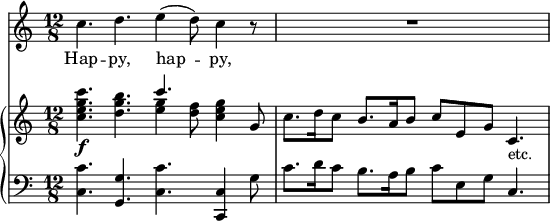
Handel's version is as follows [App. p.816 "first bar-line should be between the second and third sets of triplets, not before the first set"]:—
Happy, happy we. (Duet.)

The opening bar of the chorus imitates the original melody still more closely:—

Handel also turned this air into a gigue ('Suites de Pièces,' 1st collection, p. 43, Leipzig edition).

But it must be admitted that the beauty of the original theme has been greatly enhanced by his masterly treatment.
According to a Welsh manuscript of the time of Charles I, now in the British Museum—which though itself of the 17th century was doubtless copied or compiled from earlier records[1]—Gryffudd ab Cynan, King of North Wales, held a congress, in the nth century, for the purpose of reforming the order of the Welsh bards, and invited several of the fraternity from Ireland to assist in carrying out the contemplated reforms; the most important of which appears to have been the separation of the professions of bard and minstrel—in other words, of poetry and music; both of which had before been united in one and the same person. The next was the revision of the rules for the composition and performance of music. The '24 musical measures' were permanently established, as well as a number of keys, scales, etc.; and it was decreed that henceforth all compositions were to be written in accordance with those enactments; and that none but those who were conversant with the rules should be considered thorough musicians, or competent to undertake the instruction of others.
In this manuscript will also be found some of the most ancient pieces of music of the Britons, supposed to have been handed down from the ancient bards. The whole of the music is written for the Crwth, in a system of notation by the letters of the alphabet, with merely one line to divide bass and treble. Dr. Burney, after a life-long research into the musical notation of ancient nations, gives the following as the result:—
It does not appear from history that the Egyptians, Phoenicians, Hebrews, or any ancient people who cultivated the arts, except the Greeks and Romans, had musical characters; and these had no other symbols of sound than the letters of the alphabet, which likewise served them for arithmetical numbers and chronological dates.
The system of notation in the manuscript resembles that of Pope Gregory in the 6th century, and may have found its way into this country when he sent Augustine into Britain to reform the abuses which had crept into the services of the western churches.
St. Gregory's Notation.
A, B, C, D, E, F, G, a, b, c, d, e, f, g, aa, bb, cc, dd, ee, ff, gg.
Notation in the Ancient Welsh Manuscript.
cc dd ee ff g1 a1 b1 c1 d1 e1 f1 g̅ a̅ b̅ c̅ d̅ e̅ f̅ g• a• b• c• d• e• f•
A close resemblance to the ancient Welsh notation is to be found in a work entitled Musuryia,[2] seu praxis musicae, illius primo quae Instruments agitur certa ratio, ab Otto-
- ↑ The prose contained in the MS. is to be found in Dr. John David Rhys's Welsh and Latin Grammar of 1592.
- ↑ Not to be confounded with the 'Musurgia' of Kircher. [See vol. ii. p. 438.] Othmar Luscinius was a learned Benedictine monk, and native of Strassburg. His work is in two parts; the first containing a description of the Musical Instruments in his time, and the other the rudiments of the science. To these are added two commentaries, containing the precepts of polyphonic music.

